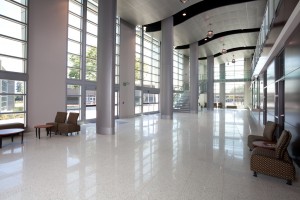How blindless windows are helping California college cut energy costs

In some states, it is illegal to tint car windows beyond a certain darkness level. Fortunately, there aren't corresponding laws about windows in buildings.
That's because windows that tint themselves electronically when the weather or interior temperatures call for its are at the center of an ongoing $280 million "green intelligent building" initiative at Chabot College in Hayward, Calif.
The SageGlass windows, made by SAGE Electrochromics, are being used in the atrium of the new Community and Student Services Center along with an ambitious ductless environmental system, says Gabrielle Blackman, a principal designer at architectural firm tBP Architecture, which was in charge of the project.
The atrium runs east to west with the sun, so it captures the most light possible. The building features radiant heating and cooling, which is contained within the atrium's floor, replacing traditional forced air heating and cooling. "Air Scoops" on the roof and ceiling help provide natural ventilation.
Blackman says that the SageGlass windows can shade the room automatically within a matter of minutes. "The tinting graduates, but you can still see in and out of the building," she says. "You let the building work for you."
Here are before and after photos:

This feature allowed the college to save money on extra shading technology. Blackman firmly believes that this sort of approach will be embraced more readily by commercial building owners in coming years.
Chabot is seeking a Silver certification under the Leadership in Energy and Environmental Design (LEED) for the new building. SAGE Electrochromics claims that the SageGlass can reduce the heating and air-conditioning equipment usage requirements by up to 25 percent, cut cooling loads by up to 20 percent, reduce peak power demand by about 26 percent and cut lighting costs by up to 60 percent.
Blackman says the college went through an external review before opting to use the windows but they embraced the approach so quickly that they didn't consider another approach. The cost of acquiring and installing the windows was more than traditional windows but the savings over time in heating and cooling costs, as well as the effect that it had on the ventilation equipment investments the college had to make, outweighed the upfront costs.
Other green technologies being used in the building include Energy Star compliant roofing, waterless urinals, metered faucets and low-flow toilets, and photovoltaic solar panels that are located in the parking lots across the college campus. Those panels provide shade while generating renewable energy for the college. The student services building also uses a building management system that senses when carbon dioxide levels inside the facility call for more fresh air circulation.
This post was originally published on Smartplanet.com